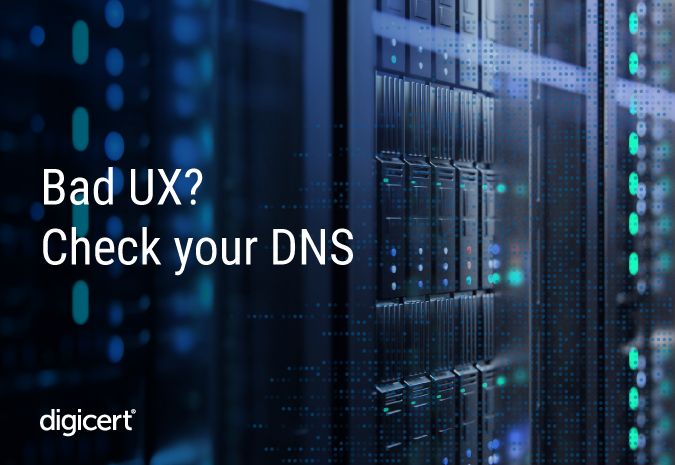
The average internet user might not understand DNS; they may not even know it exists. But at one point or another, everyone who browses the web will know the frustrations that DNS issues can cause.
Error messages, broken links, slow load times, elements that appear gradually (if they appear at all)—all contribute to a poor user experience (UX), and they’re often problems that a business could fix if they knew how to troubleshoot their DNS.
Whether you’re running a website, online service, or corporate network, knowing how to handle DNS problems will make it easier to enhance performance and security. We’ve put together some tips for measuring DNS performance and diagnosing common issues to protect against threats and deliver a positive UX.
The importance of DNS for website performance and security
Before we explore how to troubleshoot DNS issues, let’s do a quick review of what this system is and why DNS is so important to internet security and connectivity.
DNS stands for Domain Name System, and it operates like a phone book for the internet, using designated authoritative DNS servers to map domain names to numerical internet protocol (IP) addresses. In layman’s terms, DNS translates human-readable domain names (like www.digicert.com) into IP addresses (like 192.16.49.85) that computers use to identify each other on the network.
A well-functioning DNS ensures your website loads quickly and remains accessible to users worldwide. But for a poorly functioning DNS, the opposite is true—your visitors will experience slow load times, unresponsive services, and a negative UX.
DNS is also critical to web security. Attackers can exploit vulnerabilities for malicious purposes like DNS hijacking or spoofing, redirecting users to fraudulent websites and compromising their sensitive information.
Common DNS issues and their impact
We’ve already touched on some of the common issues you may need to troubleshoot, but here’s a more detailed breakdown:
- Slow DNS resolution: When DNS queries take longer than usual to resolve, website load times increase—and so does a user’s frustration.
- DNS outages: Failures within the DNS can render your website inaccessible, leading to downtime and a potential loss of business.
- DNS misconfigurations: Incorrect DNS settings can cause issues like failed lookups and routing problems, which impact your services’ reliability and accessibility.
Tips for troubleshooting your DNS
By now, you can probably see why DNS troubleshooting is important. But how do you do it? Let’s look at the key approaches you can take to address any issues that arise.
Measuring DNS performance
You can improve your site’s performance by implementing traffic management strategies and regularly measuring and monitoring your DNS. Here’s how:
- Use real-time DNS monitoring tools. Performance monitoring solutions like PerfOps offer real-time DNS monitoring, allowing you to track performance across different regions. These tools provide immediate alerts for any performance degradation, helping you address issues promptly.
- Conduct performance tests: Authoritative managed DNS providers like DigiCert offer tools to simulate DNS queries, allowing you to measure response times and identify latency sources. And with load testing, you can assess performance under various conditions.
- Analyze historical data: Reviewing historical performance data can help you identify trends and recurring issues. This analysis is crucial for long-term optimization and understanding how different changes impact performance.
Diagnosing DNS issues
When DNS issues arise, promptly diagnosing the root cause is the only way to find a quick fix. Here are some of the methods you can use:
- Check DNS resolution times: High resolution times often indicate performance issues. Tools like Traceroute can help pinpoint where delays are occurring along the query path.
- Monitor uptime and availability: Use a service like DigiCert DNS Trust Manager to regularly monitor the uptime of your DNS servers so you can detect outages and service disruptions before the problem gets too big.
- Validate DNS configurations: Misconfigurations are a common cause of DNS issues. Use validation tools to audit your DNS records to ensure they’re set up correctly. Many performance monitoring solutions offer automated audits to catch misconfigurations early.
Enhancing DNS performance
Once you've identified any issues, the next step is to use one or more of the following strategies to enhance your DNS performance.
- Implement traffic management: Traffic management features like geo-routing and load balancing can help you distribute traffic efficiently, reducing latency and improving load times for users in different regions.
- Optimize DNS routing: Analyze and optimize your DNS routing paths to ensure queries are resolved as quickly as possible. Popular performance monitoring solutions can offer detailed insights into routing efficiency.
- Use redundant DNS configurations: Redundant configurations can help prevent downtime by automatically switching to backup servers if the primary ones fail. Work with your managed DNS provider to set up failover protocols to ensure high availability.
Enhancing DNS security
And last but not least, you need strategies for supporting the critical role of DNS in online security. Here’s how you can protect your system from common threats:
- Implement DNSSEC: DNS security extensions (DNSSEC) add a layer of authentication to DNS responses, preventing tampering and ensuring data integrity. A managed DNS solution like DigiCert DNS Trust Manager can help you manage DNSSEC effectively.
- Configure rate limiting: Rate limiting helps protect your DNS servers from excessive queries like the ones used in DDoS attacks. You can mitigate the risk of service disruptions by setting thresholds on the number of queries your DNS server will respond to from a single source. This strategy is known as rate limiting, and it can significantly reduce the impact of malicious traffic and stop your DNS infrastructure from becoming a target.
- Practice continuous threat monitoring: Many performance monitoring solutions offer security monitoring tools to detect unusual activity and potential threats, making it easier to mobilize quickly when a security alert comes through.
The latest developments in digital trust
Want to learn more about topics like DNS, cybersecurity, and digital trust best practices? Subscribe to the DigiCert blog to ensure you never miss a story.







